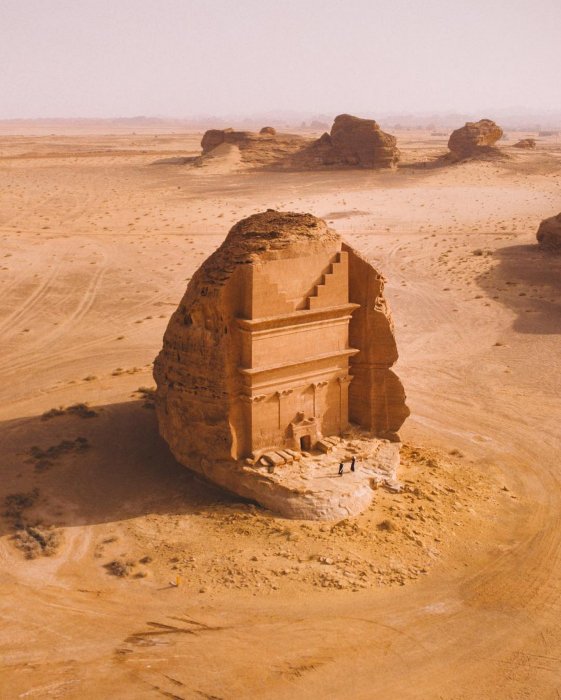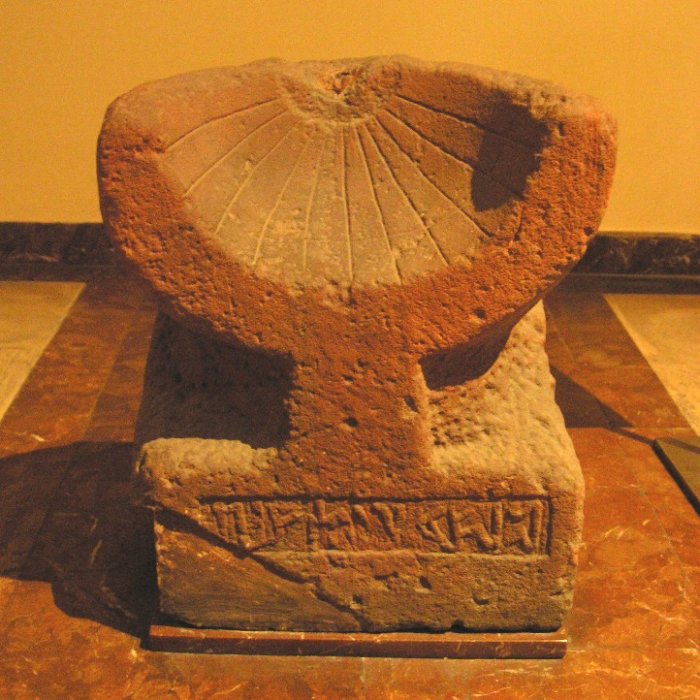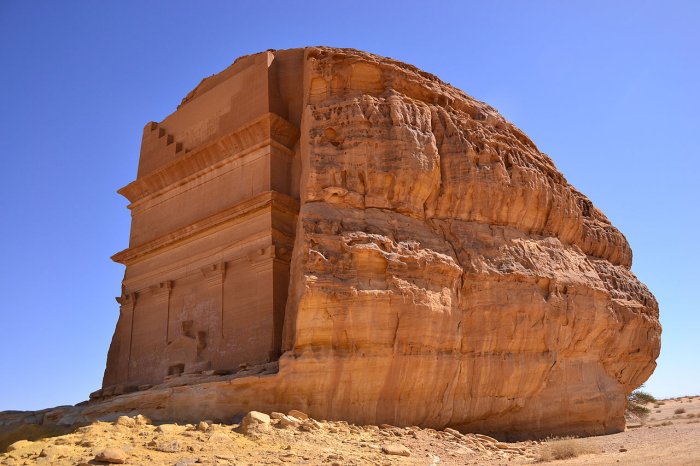Mada’in Saleh: Spectacular Rock-Cut Tombs And Monuments Reflect Great Skills Of Nabataean Builders
A. Sutherland - AncientPages.com - Located 20 km (12.4 mi) north of the Al-`Ula town, 400 km (248.5 mi) northwest of Medina, and 500 km (310.7 mi) south-east of Petra, in modern-day Jordan, the great ancient site Mada'in Saleh in Saudi Arabia continues to impress the modem world.
Aerial view of Madain Saleh. Credit: Adobe Stock - mellouk
It contains many magnificent tombs and monuments that reflect the excellent skills of the masons of their time. Mada’in Saleh, also called Al-Hijr or Hegra, dates back to the Nabataean civilization that flourished between the second and fourth century BC.
This beautiful place is considered one of the ´most important archaeological sites in Saudi Arabia and is called "The Capital of the Monuments." The site constitutes the kingdom's southernmost and largest settlement after Petra (modern-day Jordan).
The site's 111 monumental tombs, 94 decorated, and water wells are an outstanding example of the Nabataeans' architectural accomplishment and hydraulic expertise.
Mada’in Saleh is the first World Heritage site in Saudi Arabia. Although historians are not sure where the Nabataean civilization came from, there is a strong possibility that they came from the Hejaz region of northwest Saudi Arabia. Their history goes back thousands of years.
 Qasr al-Farid, an unfinished tomb that stands alone. Image source
Qasr al-Farid, an unfinished tomb that stands alone. Image source
At its peak, the Nabataean Empire stretched from modern-day Yemen to Damascus and from western Iraq into the Sinai Desert, at least, according to some historians.
No one knows how large their empire was. Written records of the Nabataean kingdom are sparse, as there are only a few surviving documents, scattered inscriptions, and graffiti.
However, many thousands of graffiti carved onto rocks and canyon walls demonstrate that almost every Nabataean could read and write, even the shepherds.
It makes us wonder why the Nabataeans did not write down their history. According to historians, the Nabataeans were nomads, dwelling in tents in the desert. They began as pastoral nomads, raising sheep, goats, and camels in the desert as many other Arabian tribes have done through the millennia. They also practiced oasis agriculture.
Yet, interestingly within a few short years, they also built spectacular and awe-inspiring monuments.
The magnificent city of Petra is so impressive that even today, tourists stare in awe at the incredible ruins. This remarkable city was hidden away in a cleft in the rock with only access through a narrow crack in a mountain.
Hegra Roman inscription dedicated to Emperor Marcus Aurelius. Image credit: aramcoworld.com - CC0 1.0
Most of the monuments and inscriptions found at the archaeological site date back to the 1st century BC and the 1st century CE. But the inscriptions in Lihyanite script and some recently discovered archaeological vestiges show evidence of human settlement as early as the 3rd or 2nd century BC.
One-third of the tombs, amongst the largest, are dated between 0-75 CE. Inscriptions engraved on rocks and facades of graves of Mada'in Saleh tell the history of this once great place, and every grave is like a cemetery for one family.
The Nabataeans watched the sky systematically and accurately, and there is proof of their astronomical observations.
According to scientists who studied the Nabataean palaces, temples, and tombs, these people were skilled astronomers. Splendid buildings were erected, bearing in mind the equinoxes, solstices, and other astronomical events that determined the Nabataean religion.
A sundial inscribed in Aramaic was found in Madain Saleh, dating back to the first century BC. Unknown ancient artist, picture by Ana al'ain - CC BY 3.0
A secondary route linked it to the port of Egra Kome, and two Nabataean sites unearthed on the shores of the Red Sea could be this port.
Considering the accounts of the Greek historian Diodorus of Sicily, it is known that the Nabataeans appeared in history before the end of the third century BC. Diodorus described them as nomadic Arab tribes whose wealth came from their involvement in the long-distance trade of incense and aromatics, mainly produced in the Yemeni region.
"The Nabataean knowledge of the location
Madain Saleh is the first World Heritage site. Image credit: Sammy Six - CC BY 2.0
of the routes and of the places where water could be found allowed them to control progressively the trans-Arabian trade route,” according to Dr. Laila Nehme, a French-Lebanese archaeologist and epigraphist of the Ancient Near East, known for her research on Nabataean writings, the evolution of the Nabataean script into the Arabic, and archaeological excavations at Petra and Mada'in Saleh.
With this important advantage also came a monopoly on the transport of trade goods. Thus, the Nabataeans could quickly accumulate wealth by imposing taxes along the prestigious international caravan trade route during late Antiquity.
Most probably, these remarkable people even started to make coins as early as the third century BC and more regularly in the second,” according to Dr. Nehme.
The ruins of the town of Hegra lie on the plain some distance from the timeless tombs and monuments.
Written by – A. Sutherland - AncientPages.com Senior Staff Writer
Updated on November 19, 2022
Copyright © AncientPages.com All rights reserved. This material may not be published, broadcast, rewritten or redistributed in whole or part without the express written permission of AncientPages.com
Expand for referencesMore From Ancient Pages
-
 Ancient Secrets Of The Masters Of Mu – Keepers Of Sacred Knowledge – Part 2
Ancient Mysteries | Aug 25, 2018
Ancient Secrets Of The Masters Of Mu – Keepers Of Sacred Knowledge – Part 2
Ancient Mysteries | Aug 25, 2018 -
 Codebreakers Crack Secrets Of The Lost Letters Of Mary, Queen Of Scots
News | Feb 8, 2023
Codebreakers Crack Secrets Of The Lost Letters Of Mary, Queen Of Scots
News | Feb 8, 2023 -
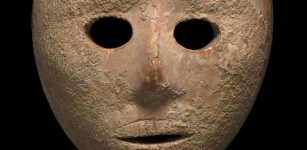 Impressive 9,000-Year-Old Stone Mask Uncovered In Southern Hebron Hills, Israel
Archaeology | Nov 30, 2018
Impressive 9,000-Year-Old Stone Mask Uncovered In Southern Hebron Hills, Israel
Archaeology | Nov 30, 2018 -
 Evidence For A Divergence Between Eastern And Western Mediterranean Indo-European Languages Finally Provided By Ancient Genomics Study
Archaeology | Jan 4, 2025
Evidence For A Divergence Between Eastern And Western Mediterranean Indo-European Languages Finally Provided By Ancient Genomics Study
Archaeology | Jan 4, 2025 -
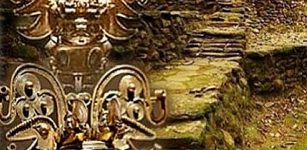 Mysterious Lost City Of The Tairona Hidden In The Jungles Of Colombia
Civilizations | Nov 9, 2018
Mysterious Lost City Of The Tairona Hidden In The Jungles Of Colombia
Civilizations | Nov 9, 2018 -
 Jan Hus: Czech Reformer And Bohemian Religious Leader Was Burned At Stake For Heresy
Featured Stories | Dec 17, 2019
Jan Hus: Czech Reformer And Bohemian Religious Leader Was Burned At Stake For Heresy
Featured Stories | Dec 17, 2019 -
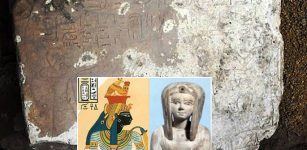 Limestone Stela Of Liberation Discovered In Kom Ombo Temple In Aswan, Egypt
Archaeology | Oct 17, 2018
Limestone Stela Of Liberation Discovered In Kom Ombo Temple In Aswan, Egypt
Archaeology | Oct 17, 2018 -
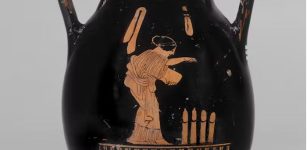 The Long And Satisfying 28,000-Year History Of The Dildo
Featured Stories | Feb 27, 2023
The Long And Satisfying 28,000-Year History Of The Dildo
Featured Stories | Feb 27, 2023 -
 How Saul, A Farmer Boy Became The First King Of Israel
Featured Stories | Jan 20, 2022
How Saul, A Farmer Boy Became The First King Of Israel
Featured Stories | Jan 20, 2022 -
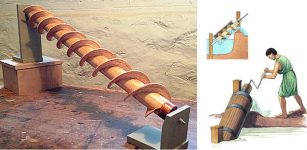 Archimedes’ Screw: Ancient Invention Used To Transfer Water To Higher Levels
Ancient History Facts | Aug 30, 2018
Archimedes’ Screw: Ancient Invention Used To Transfer Water To Higher Levels
Ancient History Facts | Aug 30, 2018 -
 Agriculture In North America Led To Changes In Age-Independent Mortality
Archaeology | Jan 24, 2023
Agriculture In North America Led To Changes In Age-Independent Mortality
Archaeology | Jan 24, 2023 -
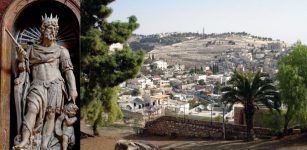 The City Of David – Why Is It So Controversial?
Biblical Mysteries | Jan 9, 2019
The City Of David – Why Is It So Controversial?
Biblical Mysteries | Jan 9, 2019 -
 On This Day In History: Battle of Oosterweel Was Fought – On Mar 13, 1567
News | Mar 13, 2017
On This Day In History: Battle of Oosterweel Was Fought – On Mar 13, 1567
News | Mar 13, 2017 -
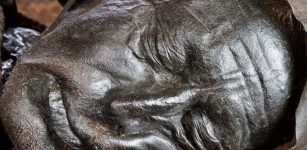 Mystery Of Europe’s Bog Body Phenomenon Solved By Scientists
Archaeology | Jan 12, 2023
Mystery Of Europe’s Bog Body Phenomenon Solved By Scientists
Archaeology | Jan 12, 2023 -
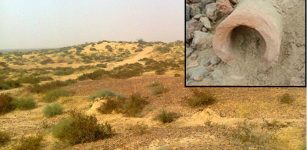 Indus Civilization And Complex Patterns Of Urbanity – New Study
Archaeology | Feb 21, 2022
Indus Civilization And Complex Patterns Of Urbanity – New Study
Archaeology | Feb 21, 2022 -
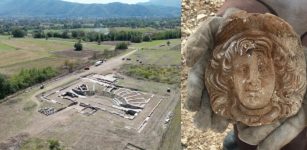 Roman ‘Backwater’ Challenges Major Assumptions About The Ancient Empire’s Decline
Archaeology | Dec 12, 2023
Roman ‘Backwater’ Challenges Major Assumptions About The Ancient Empire’s Decline
Archaeology | Dec 12, 2023 -
 On This Day In History: Cyrus The Great And His Army Took Babylon – On Oct 12, 539 BC
News | Oct 12, 2016
On This Day In History: Cyrus The Great And His Army Took Babylon – On Oct 12, 539 BC
News | Oct 12, 2016 -
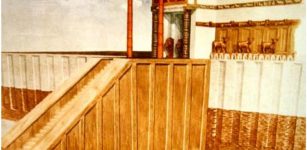 Beautiful Temple Dedicated To Ninhursag, Goddess Of Childbirth And Divine Protector Of Wild Animals
Civilizations | Jan 3, 2017
Beautiful Temple Dedicated To Ninhursag, Goddess Of Childbirth And Divine Protector Of Wild Animals
Civilizations | Jan 3, 2017 -
 The First ‘Viking’ Was A Bronze Age Man
Civilizations | Jul 26, 2024
The First ‘Viking’ Was A Bronze Age Man
Civilizations | Jul 26, 2024 -
 Aqrabuamelu – Mysterious Scorpion Men In Babylonian Mythology
Featured Stories | Jan 19, 2016
Aqrabuamelu – Mysterious Scorpion Men In Babylonian Mythology
Featured Stories | Jan 19, 2016

